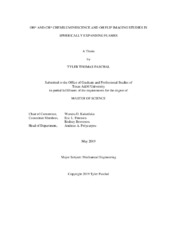| dc.description.abstract | The work performed in this research is aimed at developing two repeatable methods for imaging spherically expanding flames operated in a constant volume flame vessel. The first, passive diagnostic method imaged the chemiluminescence emission of radicals OH* and CH* in a range of flame equivalence ratios (0.7–1.3) at a rate of 2 kHz, and the data were used to measure the laminar flame speed via the same image processing used for measuring laminar flame speed using conventional schlieren imaging experiments. The optical filters for OH* and CH* (315 ± 15 nm and 434 ± 17 nm, respectively) applied to the high-speed, intensified imaging system created volumeintegrated species-specific images of spherically expanding flames. The radial profiles of Abel inverted images showed a clear intensity peak near the edge of the flame corresponding to the flame front. The full-width-at-half-maximum (FWHM) in these radial profile curves estimated a thickness of the radical zone at the edge of the flame, and these thicknesses were on the order of 1mm, and their time histories were evaluated. The second experimental method introduced a laser excitation source for single-shot planar laser-induced fluorescence (PLIF) of the hydroxyl radical (OH). The PLIF apparatus was optimized to create a repeatable timing sequence to open the camera exposure gate over a single laser pulse, and the resulting images showed twodimensional spatial distribution of ground-state OH in the methane-air flames. Quantitative OH calibration was performed using a Hencken calibration burner to compute a number-density to pixel-intensity ratio for each equivalence ratio, and this ratio was applied to the images to show absolute OH number densities in the 2-D plane of the flame.
. The images show a time-series of the propagation of a stoichiometric, methane-air flame and the change of OH concentration at a fixed flame radius across a range of equivalence ratios (0.7–1.3). Radial profiles of OH reveal differences between lean and rich flame radical gradients. Proof-of-principle OH PLIF images of a turbulent flame is also presented. Future experiments will use this data for validating detailed chemical kinetics models of spherically expanding flames. | en |


